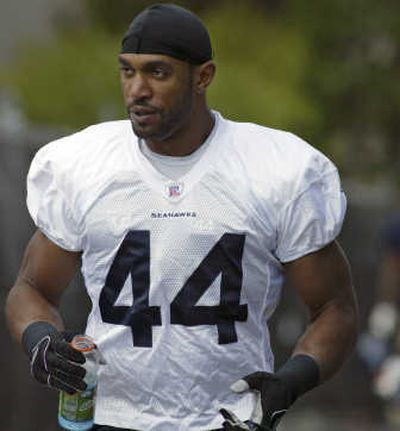A weight problem

Patrick Kerney plans on eating two turkey dinners this afternoon – one at each of the friends’ houses that he’ll be visiting for his holiday meal. But he’s got to be finished by 7 p.m., and not a second later.
Because that will give him enough time to digest and recover before tearing into the big bowl of pasta he eats every night before he goes to bed.
Kerney is one of those NFL players – and there are more than you might expect – who have to work to keep on the weight. While he says that “Mother Nature made me a 230-pound guy,” Kerney’s playing weight is 275 pounds.
And so eating can sometimes feel like a job.
“There’s a point in most meals where you’re done filling your body, and now it’s about satisfying the work clock,” said Kerney, the Seattle Seahawks’ 6-foot-5 defensive end. “I have to keep eating even when I don’t want to.”
Kerney’s so-called problem is not only a source of contention with the four sisters who give him the evil eye whenever he walks into a restaurant and intentionally orders the dish with the highest calorie count, but he’s also got a few teammates feeling green with envy.
“These little guys around here can eat all the time, just to keep the weight on, and we’ve got to watch our weight,” said offensive lineman Sean Locklear, whose listed weight is 308 pounds. “That’s tough.”
The Seahawks’ locker room, consistent with any other in the NFL, is made up mostly of players at either end of the nourishment spectrum. Many of the linemen struggle to keep off weight, while a lot of others are battling the bulge by trying to keep it on.
“That’s why I eat so much junk, so I can keep on the weight,” linebacker Julian Peterson said. “The biggest thing for me is to eat as much as possible to maintain the weight. Because during the game, I can lose as much as 8 to 10 pounds – easily. So I have to eat.”
Watching Peterson eat can be frustrating, not just for bigger teammates but also for anyone who’s ever tried to diet. The 6-foot-3 specimen has a ripped physique and boasts 3 percent body fat – way below the 20 percent national average for men in his age group. While he looks like the kind of guy who might survive on alfalfa sprouts and an occasional celery stick, nothing could be further from the truth.
“Donuts, chips, anything,” he said when asked what kinds of foods are in his diet. “If it’s got fat calories, I’ll eat it. Even a little Pop Tart here and there.”
That doesn’t go over well with some teammates who watch with envious eyes as Peterson breezes through the cafeteria.
“They get mad at me all the time,” Peterson said with a nice-to-be-me shrug. “Rocky (Bernard, a 300-plus pound defensive tackle), especially. He’s like, ‘Man, you come in here eating whatever you want: cheeseburgers, fries.’ I’m like, ‘I’m sorry. What do you want me to do about it?’ “
Peterson is not alone in his so-called “problem” of high metabolism.
Wide receiver Bobby Engram and safety Brian Russell are also in a constant battle to keep the weight on.
“It’s hard to do because we run so much, especially as the year goes on,” said Engram, whose 5-foot-10, 192-pound frame is more muscular than fans might expect from such a diminutive receiver. “I’m just trying to get three square meals per day and eating healthy snacks as much as I can in between the meals. I could lose 4 or 5 pounds like that.”
Russell is a 210-pound safety for the Seahawks who admits to using legal nutritional additives like Creatine to add bulk. He was a 195-pound quarterback during his first two-and-a-half years as a college player, but the 6-2 Russell knows that weight won’t cut it as an NFL safety.
“If I go into a collision at 195 pounds, I will feel it a lot more the next day,” he said. “And that wears you down.”
Players like Bernard, Locklear and some of the Seahawks’ other offensive linemen don’t have much sympathy. They are among those players who have to struggle to get down to a certain weight for Friday weigh-ins during the season.
“It’s been good this season because it’s been warm, so when you go out to practice you sweat off those pounds,” said Locklear, who has – figuratively speaking – had to sweat out a few weigh-ins in past seasons. “I’ve been maintaining my weight pretty good this year. I haven’t had any problems so far.”
The interesting thing is what happens to some players after retirement. While a 2005 study revealed that many NFL players struggle with obesity, there are plenty of retired players who go the other way. Former Seahawks Robbie Tobeck and Chad Eaton are among those who dropped more than 50 pounds within months of retirement.
“You either go one of two ways: you either get really skinny or really fat,” Engram said. “Nobody’s really kind of stayed the same. Whichever way you choose to go, it’s going to depend on your eating habits.”
Notes
Another Seattle Seahawks practice came and went without Shaun Alexander on Wednesday, and that likely means the team will be without their star running back for a third consecutive game. Coach Mike Holmgren reiterated 80 minutes before Wednesday’s practice that Alexander would not play in Sunday’s game against St. Louis unless he practiced all week. When Alexander sat out the afternoon session to rest his injured left knee, that all but ruled him out of the game.